Corrosion Behavior of Cold-Rolled and Solution-Treated Fe36Mn20Ni20Cr16Al5Si3 HEA in Different Acidic Solutions
Abstract
1. Introduction
2. Materials and Methods
3. Results and Discussion
3.1. Material Characterizations
3.2. Corrosion Behavior
3.2.1. Corrosion Resistance in 0.6 M NaCl
3.2.2. Corrosion Resistance in in 0.6 M NaCl + 0.5 M H2SO4
3.2.3. Corrosion Resistance in in 0.6 M NaCl + 1 M H2SO4
4. Corrosion Mechanism
5. Conclusions
- The Fe36Mn20Ni20Cr16Al5Si3 alloy was composed mainly of FCC phase in the cold-rolled condition in addition to few amounts of the BCC/B2 phase and other intermetallics that were precipitated at the grain boundaries after subsequent solution annealing.
- In 0.6 M NaCl solution, the corrosion resistance of the cold-rolled Fe36Mn20Ni20Cr16Al5Si3 HEA is higher compared with that of the solution annealed condition and the SS304 alloy.
- The addition of H2SO4 to the 0.6 M NaCl deplete the Cr and Mn of the as cold-rolled condition and decrease the Fe36Mn20Ni20Cr16Al5Si3 alloy corrosion resistance. Under these conditions, the solution annealed Fe36Mn20Ni20Cr16Al5Si3 HEA showed the best corrosion resistance.
- The surface passive films provide the protection for the underlying HEA from further dissolution which improve the corrosion resistance in H2SO4 solution.
Author Contributions
Funding
Institutional Review Board Statement
Informed Consent Statement
Data Availability Statement
Acknowledgments
Conflicts of Interest
References
- Shi, Y.; Yang, B.; Liaw, P.K. Corrosion-Resistant High-Entropy Alloys: A Review. Metals 2017, 7, 43. [Google Scholar] [CrossRef]
- Soare, V.; Burada, M.; Constantin, I.; Mitrica, D.; Badilit, V.; Caragea, A.; Târcolea, M. Electrochemical deposition and microstructural characterization of AlCrFeMnNi and AlCrCuFeMnNi high entropy alloy thin films. Appl. Surf. Sci. 2015, 358, 533–539. [Google Scholar] [CrossRef]
- Beverskog, B.; Puigdomenech, I. Revised pourbaix diagrams for iron at 25–300 °C. Corros. Sci. 1996, 38, 2121–2135. [Google Scholar] [CrossRef]
- kukshal, V.; Patnaik, A.; Bhat, I.K. Effect of Mn on corrosion and thermal behaviour of AlCr1.5CuFeNi2Mnx high-entropy alloys. IOP Conf. Ser. Mater. Sci. Eng. 2018, 377, 012023. [Google Scholar] [CrossRef]
- Luo, H.; Li, Z.M.; Mingers, A.M.; Raabe, D. Corrosion behavior of an equiatomic CoCrFeMnNi high-entropy alloy compared with 304 stainless steel in sulfuric acid solution. Corros. Sci. 2018, 134, 131–139. [Google Scholar] [CrossRef]
- Shi, Y.Z.; Yang, B.; Xie, X.; Brechtl, J.; Dahmen, K.A.; Liaw, P.K. Corrosion of AlxCoCrFeNi high-entropy alloys: Al-content and potential scan-rate dependent pitting behavior. Corros. Sci. 2017, 119, 33–45. [Google Scholar] [CrossRef]
- Niu, X.L.; Wang, L.J.; Sun, D.; Julius, J. Research on microstructure and electrochemical properties of Al_xFeCoCrNiCu(x=0.25,0.5,1.0) high-entropy alloys. J. Funct. Mater. 2013, 4, 532–535. [Google Scholar]
- Chou, Y.; Wang, Y.; Yeh, J.; Shih, H. Pitting corrosion of the high-entropy alloy Co1.5CrFeNi1.5Ti0.5Mo0.1 in chloride-containing sulphate solutions. Corros. Sci. 2010, 52, 3481–3491. [Google Scholar] [CrossRef]
- Gorr, B.; Mueller, F.; Christ, H.-J.; Chen, H.; Kauffmann, A.; Heilmaier, M. High temperature oxidation behavior of an equimolar refractory metal-based alloy 20Nb–20Mo–20Cr–20Ti–20Al with and without Si addition. J. Alloys Compd. 2016, 688, 468–477. [Google Scholar] [CrossRef]
- Quiambao, K.F.; McDonnell, S.J.; Schreiber, D.K.; Gerard, A.Y.; Freedy, K.M.; Lu, P.; Saal, J.E.; Frankel, G.S.; Scully, J.R. Passivation of a corrosion resistant high entropy alloy in non-oxidizing sulfate solutions. Acta Mater. 2019, 164, 362–376. [Google Scholar] [CrossRef]
- Chen, Y.Y.; Duval, T.; Hung, U.D.; Yeh, J.W.; Shih, H.C. Microstructure and electrochemical properties of high entropy alloys—A comparison with type-304 stainless steel. Corros. Sci. 2005, 47, 2257–2279. [Google Scholar] [CrossRef]
- Qiu, Y.; Thomas, S.; Gibson, M.A.; Fraser, H.L.; Birbilis, N. Corrosion of high entropy alloys. NPJ Mater. Degrad. 2017, 1, 15. [Google Scholar] [CrossRef]
- Qiu, Y.; Thomas, S.; Fabijanic, D.; Barlow, A.J.; Fraser, H.L.; Birbilis, N. Microstructural evolution, electrochemical and corrosion properties of AlxCoCrFe-NiTiy high entropy alloys. Mater. Des. 2019, 170, 107698. [Google Scholar] [CrossRef]
- Lu, C.W.; Lu, Y.S.; Lai, Z.H.; Yen, H.W.; Lee, Y.L. Comparative corrosion behavior of Fe50Mn30Co10Cr10 dual-phase high-entropy alloy and CoCrFeMnNi high-entropy alloy in 3.5 wt.% NaCl solution. J. Alloys Compd. 2020, 842, 155824. [Google Scholar] [CrossRef]
- Zhu, M.; Zhang, Q.; Zhao, B.Z.; Yuan, Y.F.; Guo, S.Y. Effect of potential on the characteristics of passive film on a CoCrFeMnNi high-entropy alloy in carbonate/bicarbonate solution. J. Mater. Eng. Perform. 2021, 30, 918–930. [Google Scholar] [CrossRef]
- Li, Q.H.; Yue, T.M.; Guo, Z.N.; Lin, X. Microstructure and corrosion properties of AlCoCrFeNi high entropy alloy coatings deposited on AISI 1045 steel by the electrospark process. Metall. Mater. Trans. A-Phys. Metall. Mater. Sci. 2013, 44, 1767–1778. [Google Scholar] [CrossRef]
- Feng, H.; Li, H.B.; Wu, X.L.; Jiang, Z.H.; Zhao, S.; Zhang, T.; Xu, D.K.; Zhang, S.C.; Zhu, H.C.; Zhang, B.B.; et al. Effect of nitrogen on corrosion behaviour of a novel high nitrogen medium-entropy alloy CrCoNiN manufactured by pressurized metallurgy. J. Mater. Sci. Technol. 2018, 34, 1781–1790. [Google Scholar] [CrossRef]
- Hsu, Y.J.; Chiang, W.C.; Wu, J.K. Corrosion behavior of FeCoNiCrCux high-entropy alloys in 3.5% sodium chloride solution. Mater. Chem. Phys. 2005, 92, 112–117. [Google Scholar] [CrossRef]
- Rodriguez, A.; Tylczak, J.H.; Ziomek-Moroz, M. Corrosion behavior of CoCrFeMnNi high-entropy alloys (HEAs) under aqueous acidic conditions. ECS Trans. 2017, 77, 741–752. [Google Scholar] [CrossRef]
- Torbati-Sarraf, H.; Shabani, M.; Jablonski, P.D.; Pataky, G.J.; Poursaee, A. The influence of incorporation of Mn on the pitting corrosion performance of CrFeCoNi High Entropy Alloy at different temperatures. Mater. Des. 2019, 184, 108170. [Google Scholar] [CrossRef]
- Mahmoud, E.R.I.; Shaharoun, A.; Gepreel, M.A.; Ebied, S. Phase Prediction, Microstructure and Mechanical Properties of Fe–Mn–Ni–Cr–Al–Si High Entropy Alloys. Metals 2022, 12, 1164. [Google Scholar] [CrossRef]
- Mahmoud, E.R.I.; Shaharoun, A.; Gepreel, M.A.; Ebied, S. Studying the Effect of Cold Rolling and Heat Treatment on the Microstructure and Mechanical Properties of the Fe36Mn20Ni20Cr16Al5Si3 High Entropy Alloy. Entropy 2022, 24, 1040. [Google Scholar] [CrossRef]
- Mohamed, L.Z.; Gepreel, M.A.H.; Abdelfatah, A. Corrosion behavior of Al12Cr12Fe35Mn21Ni20 high entropy alloy in different acidic media. Chem. Pap. 2021, 75, 6265–6274. [Google Scholar] [CrossRef]
- Abdelfatah, A.; Raslan, A.M.; Mohamed, L.Z. Corrosion Characteristics of 304 Stainless Steel in Sodium Chloride and Sulfuric Acid Solutions. Int. J. Electrochem. Sci. 2022, 17, 220417. [Google Scholar] [CrossRef]
- Paunovic, M.; Schlesinger, M. Fundamentals of Electrochemical Deposition, 2nd ed.; John Wiley and Sons: Hoboken, NJ, USA, 2005; p. 373. [Google Scholar]
- Sherif, E.S.M. A Comparative Study on the Electrochemical Corrosion Behavior of Iron and X-65 Steel in 4.0 wt.% Sodium Chloride Solution after Different Exposure Intervals. Molecules 2014, 19, 9962–9974. [Google Scholar] [CrossRef] [PubMed]
- Sherif, E.S.M.; Erasmus, R.M.; Comins, J.D. In Situ Raman spectroscopy and electrochemical techniques for studying corrosion and corrosion inhibition of iron in sodium chloride solutions. Electrochim. Acta 2010, 55, 3657–3663. [Google Scholar] [CrossRef]
- Sherif, E.S.M. Effects of 5-(3-aminophenyl)-tetrazole on the inhibition of unalloyed iron corrosion in aerated 3.5% sodium chloride solutions as a corrosion inhibitor. Mater. Chem. Phys. 2011, 129, 961–967. [Google Scholar] [CrossRef]
- Sherif, E.S.M. Comparative study on the inhibition of iron corrosion in aerated stagnant 3.5 wt.% sodium chloride solutions by 5-phenyl-1H-tetrazole and 3-amino-1,2,4-triazole. Ind. Eng. Chem. Res. 2013, 52, 14507–14513. [Google Scholar] [CrossRef]
- Sulaiman, Q.; Taie, A.; Hassan, D.M. Commission of Research and Industrial Development, Evaluation of Sodium Chloride and Acidity Effect on Corrosion of Buried Carbon Steel Pipeline in Iraqi Soil. Iraqi J. Chem. Pet. Eng. 2014, 15, 1–8. [Google Scholar]
- Maréchal, L.; Perrin, S.; Hoerlé, S.; Mazaudier, F.; Dillmann, P. A modelling of the mechanisms occurring during the atmospheric corrosion of iron. In Proceedings of the Advances for Future Nuclear Fuel Cycles, Nimes, France, 21–24 June 2004; pp. 3–17. [Google Scholar]
- Fu, Y.; Li, J.; Luo, H.; Du, C.; Li, X. Recent advances on environmental corrosion behavior and mechanism of high-entropy alloys. J. Mater. Sci. Technol. 2021, 80, 217–233. [Google Scholar] [CrossRef]
- Li, W.; Guo, W.; Zhang, H.; Xu, H.; Chen, L.; Zeng, J.; Liu, B.; Ding, Z. Influence of Mo on the Microstructure and Corrosion Behavior of Laser Cladding FeCoCrNi High-Entropy Alloy Coatings. Entropy 2022, 24, 539. [Google Scholar] [CrossRef] [PubMed]
- Deyab, M.A. The influence of different variables on the electrochemical behavior of mild steel in circulating cooling water containing aggressive anionic species. J. Solid State Electrochem. 2009, 13, 1737–1742. [Google Scholar] [CrossRef]
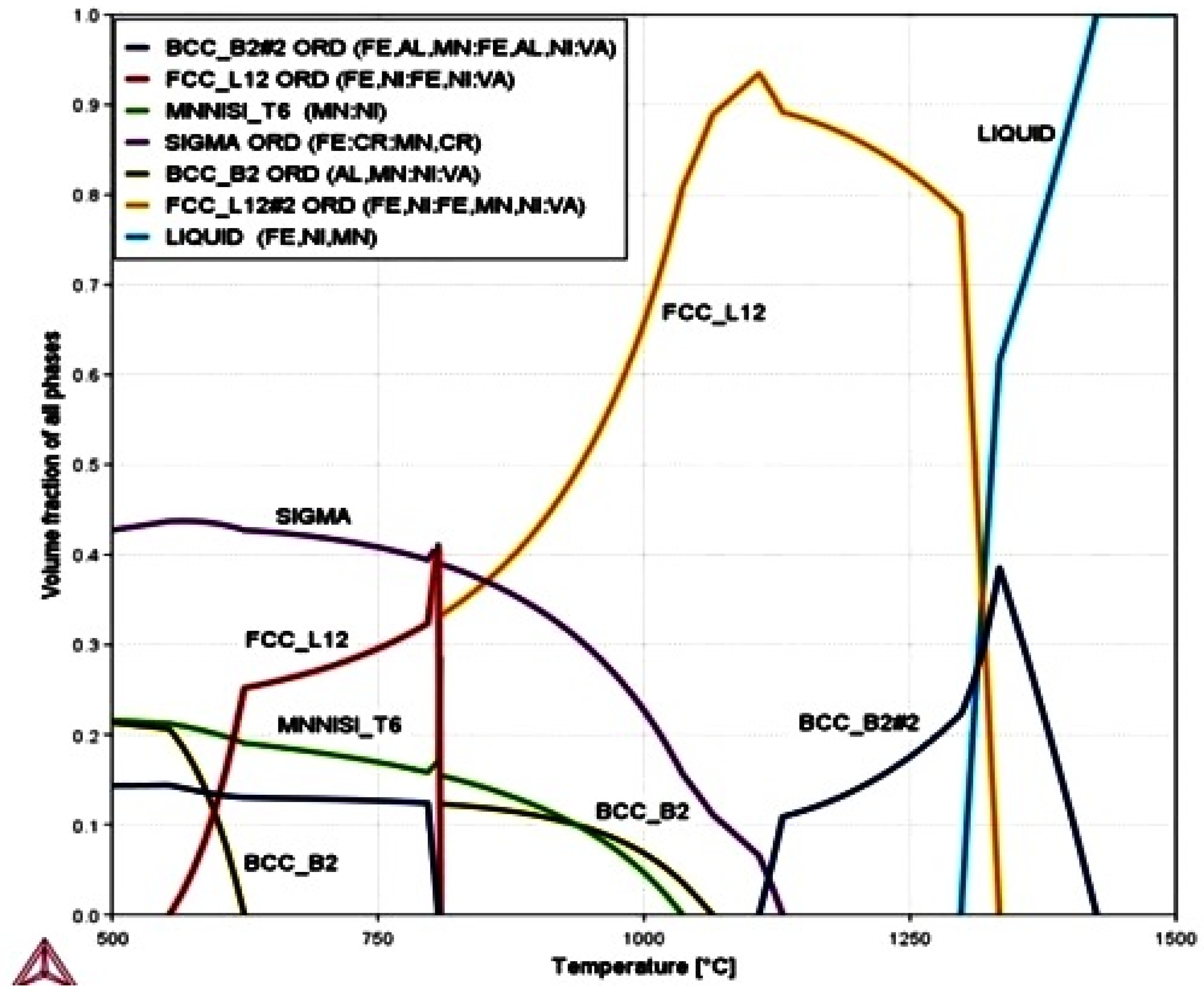
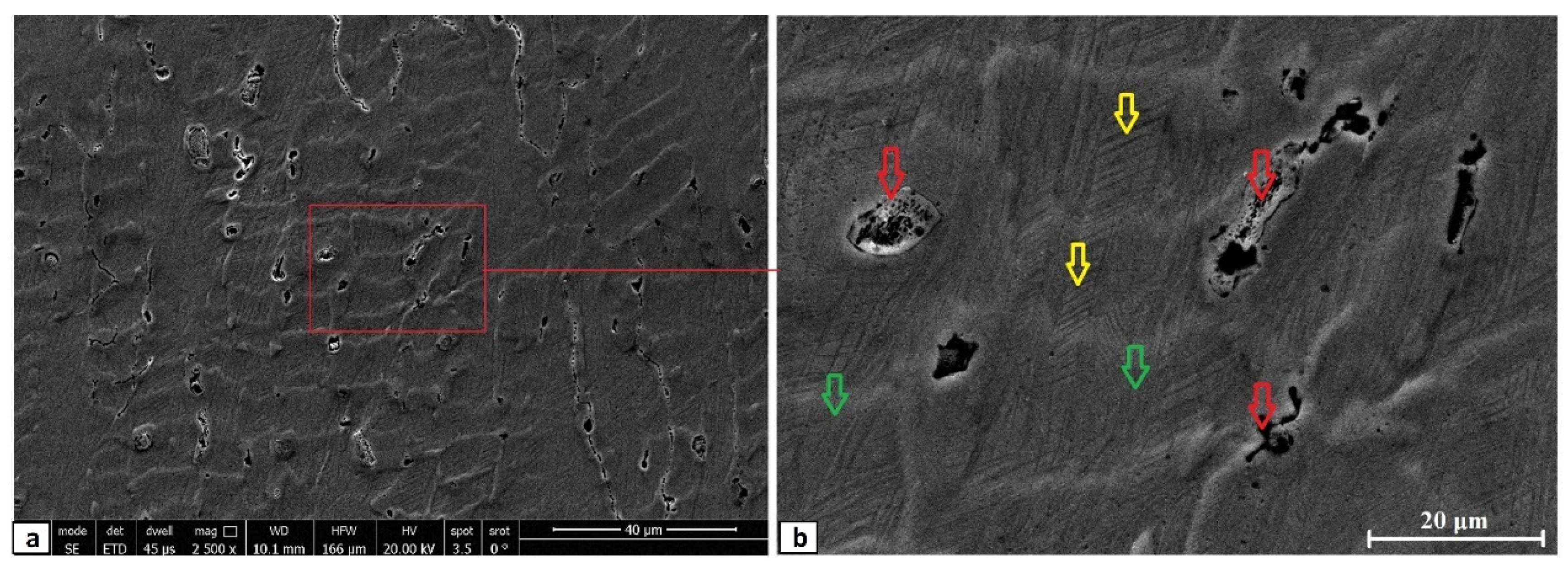
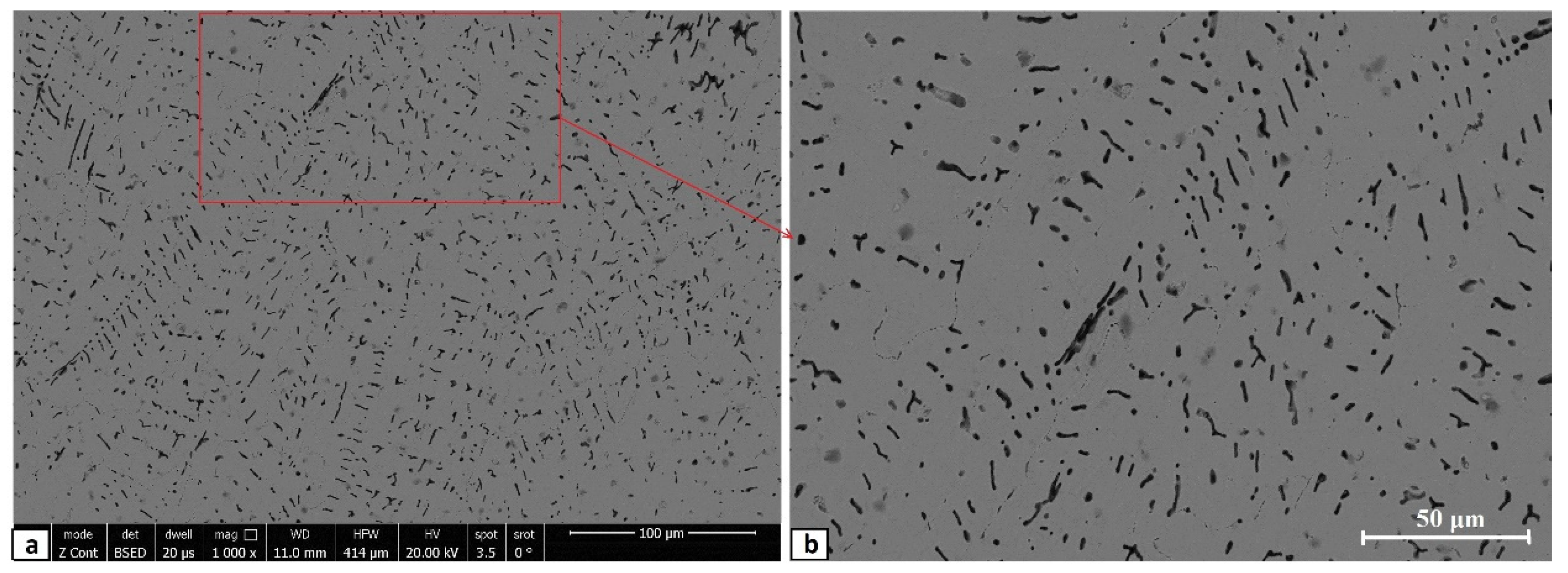
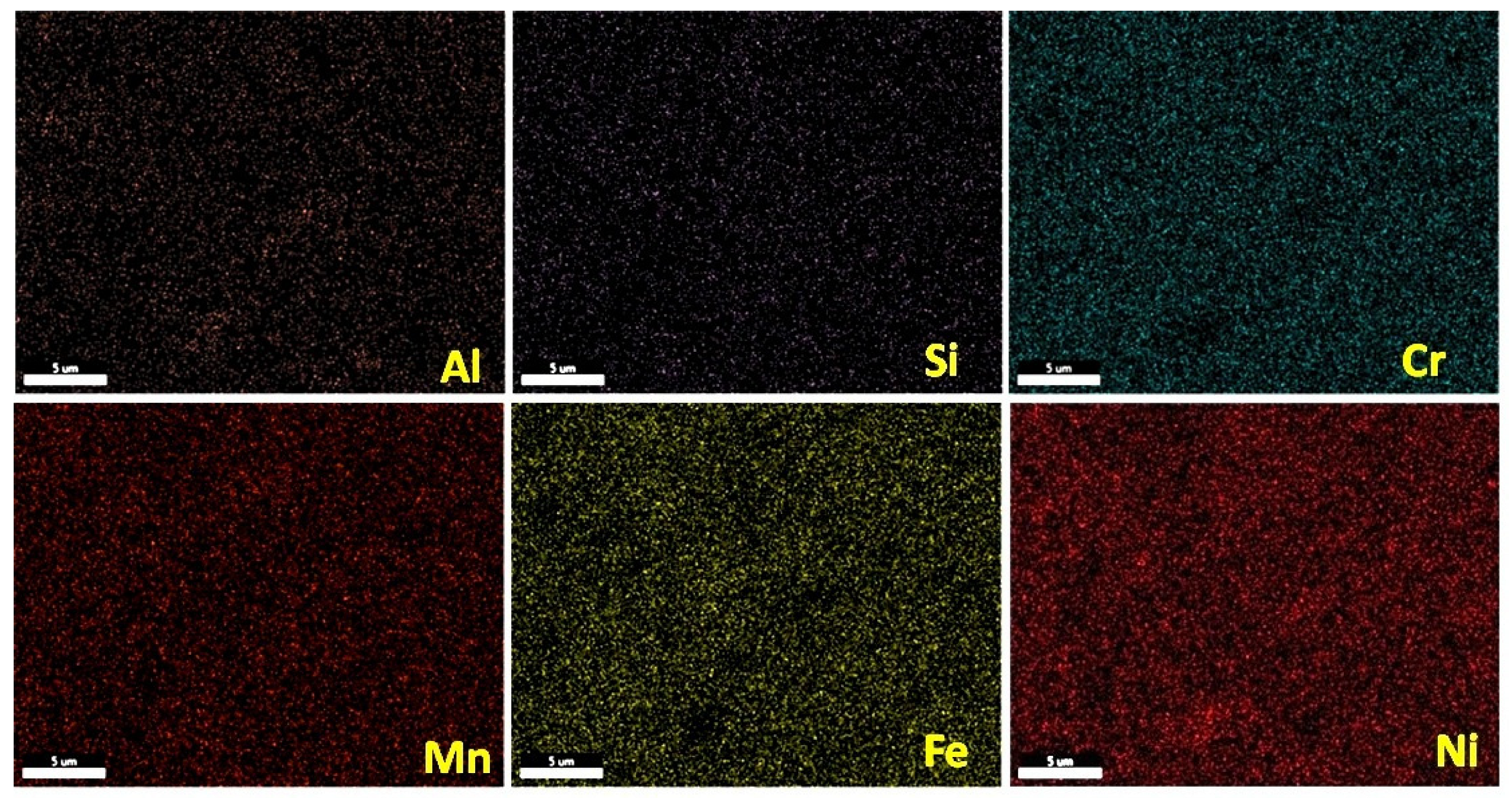
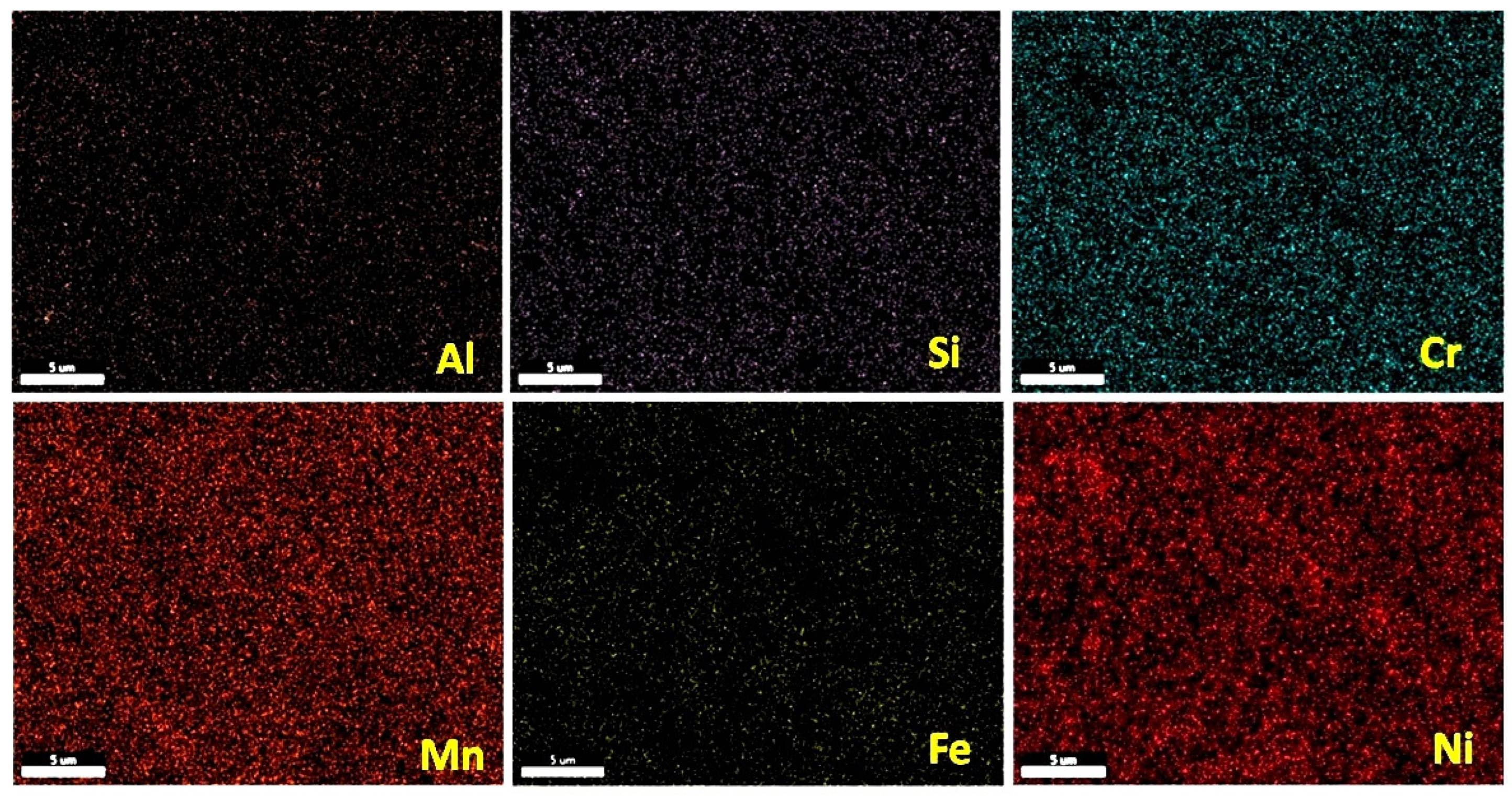

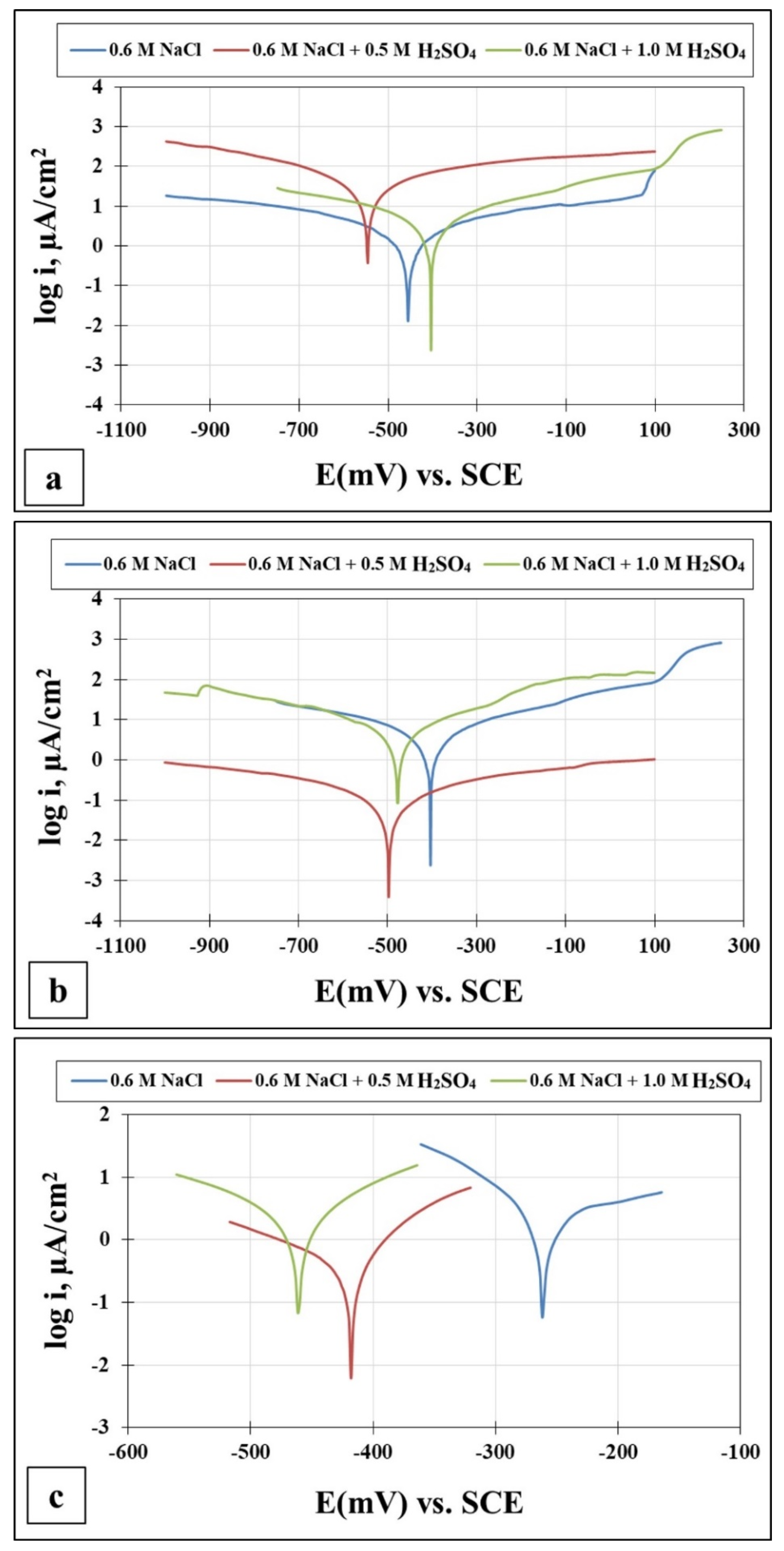
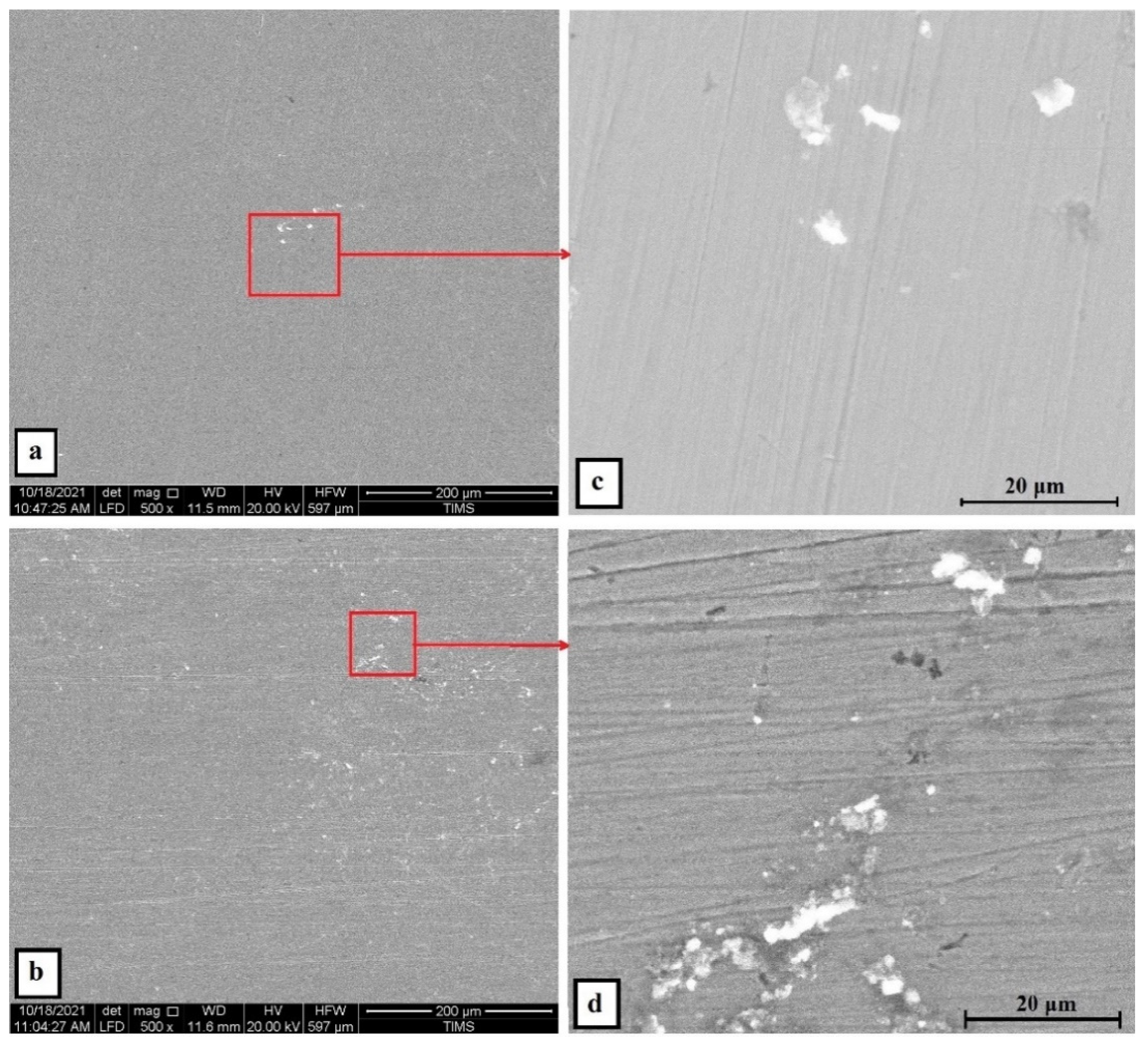
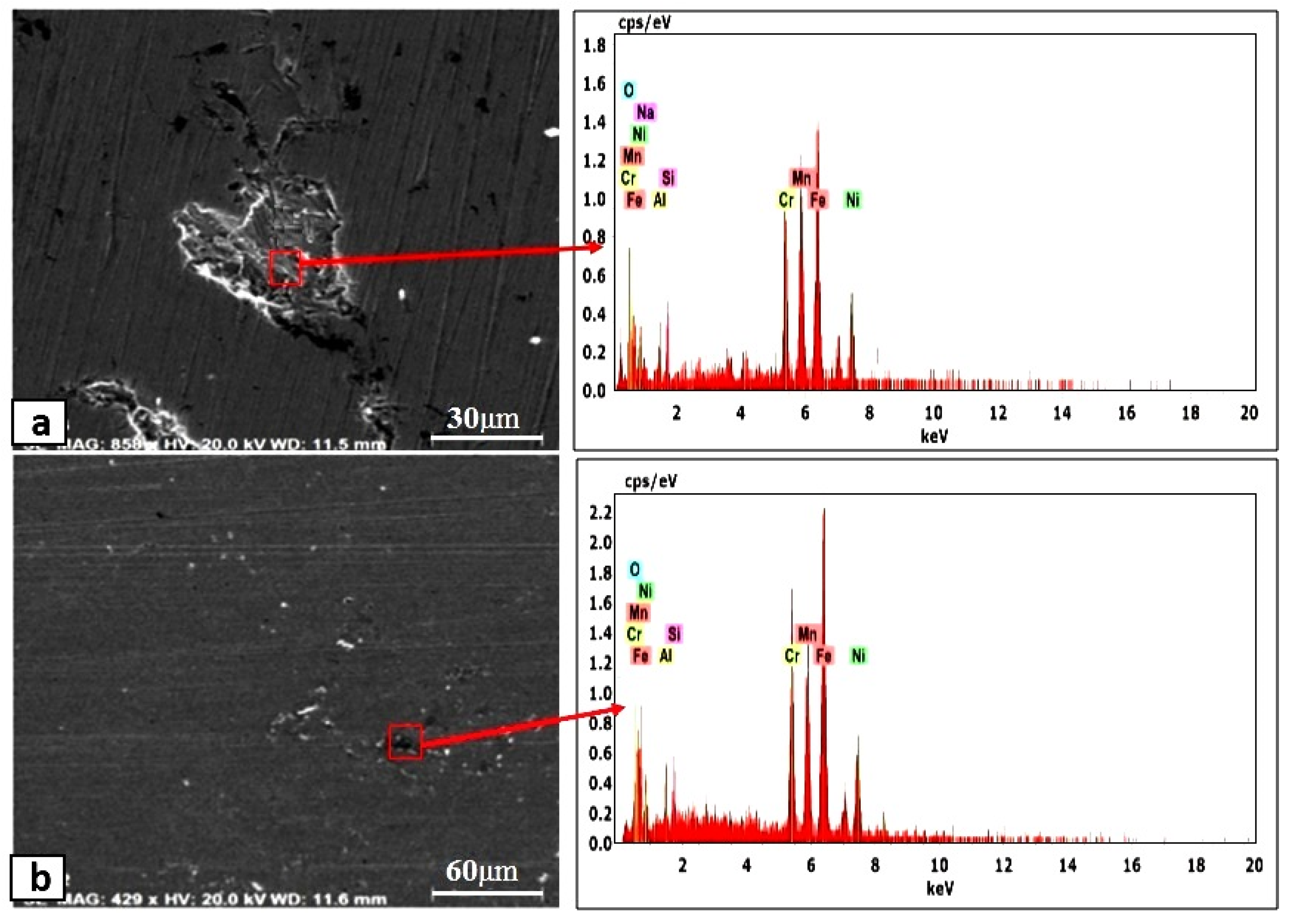
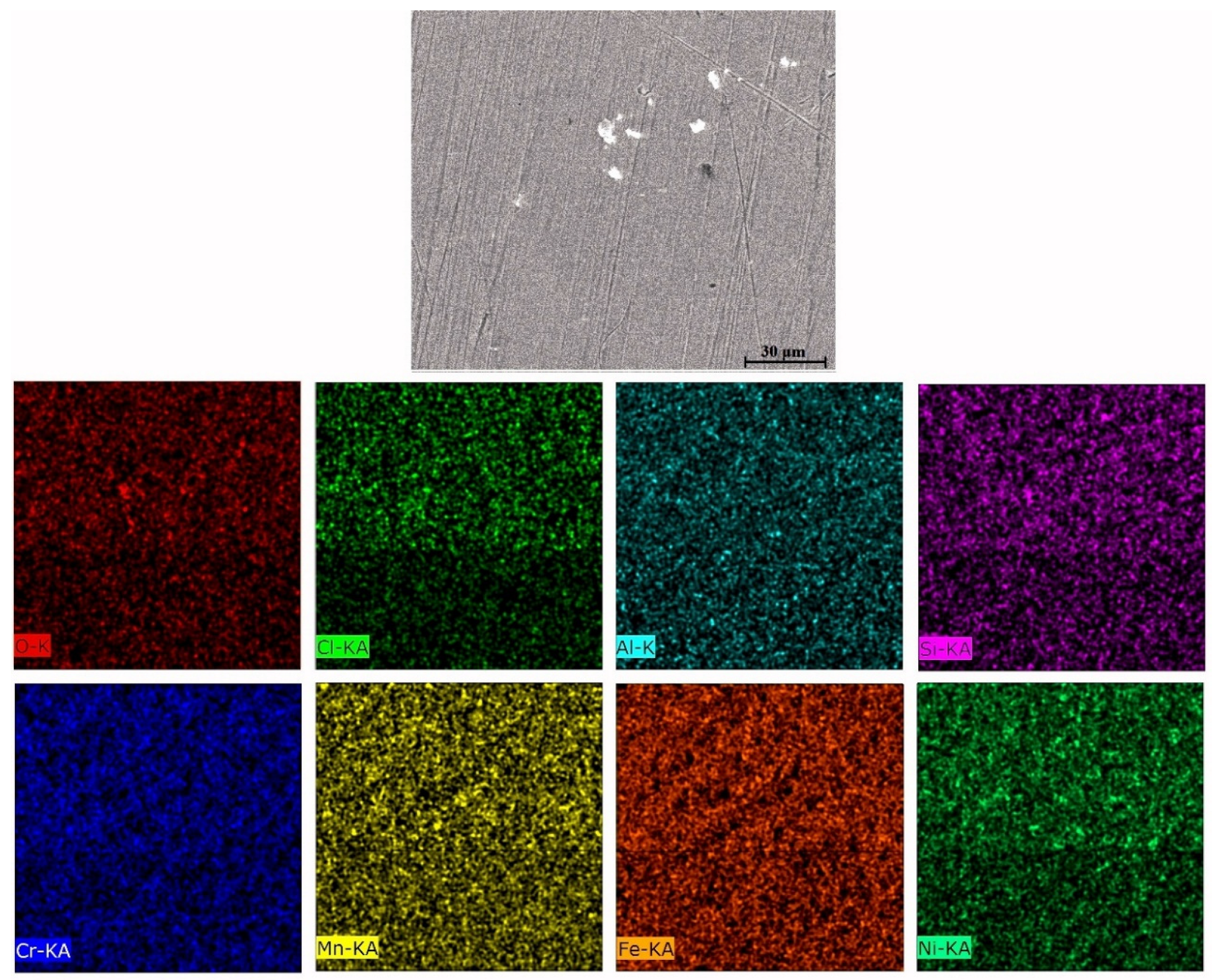

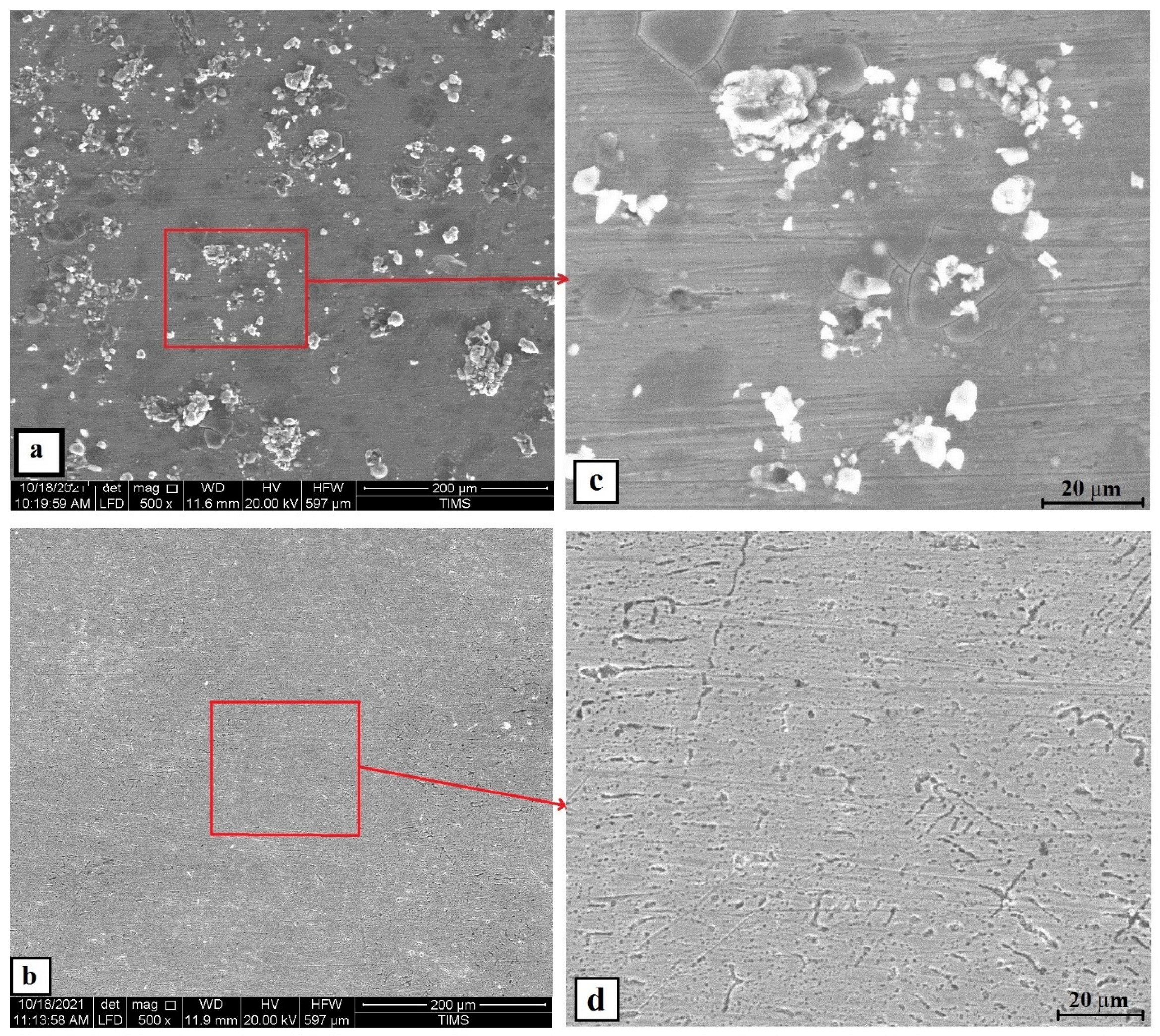
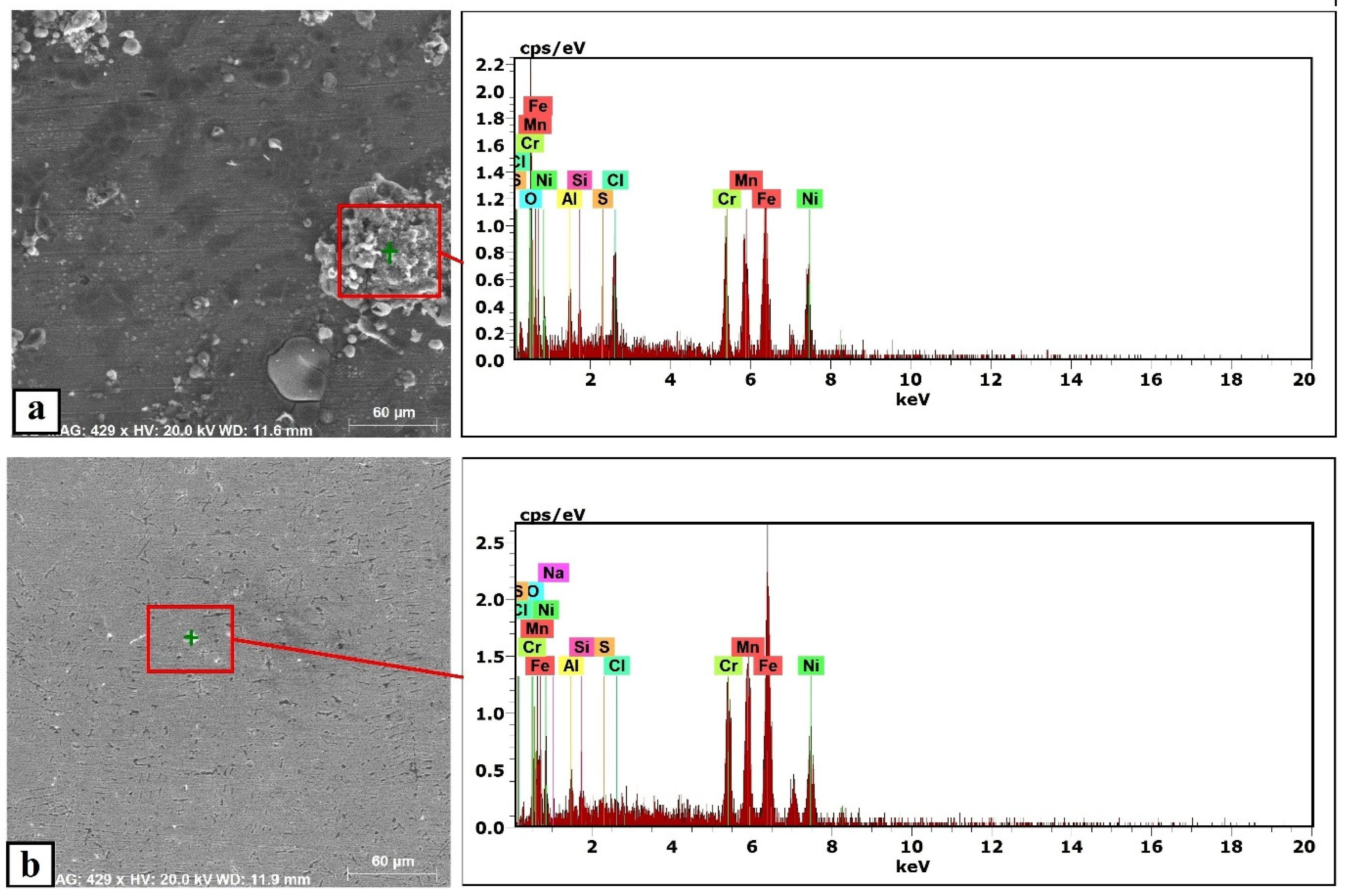

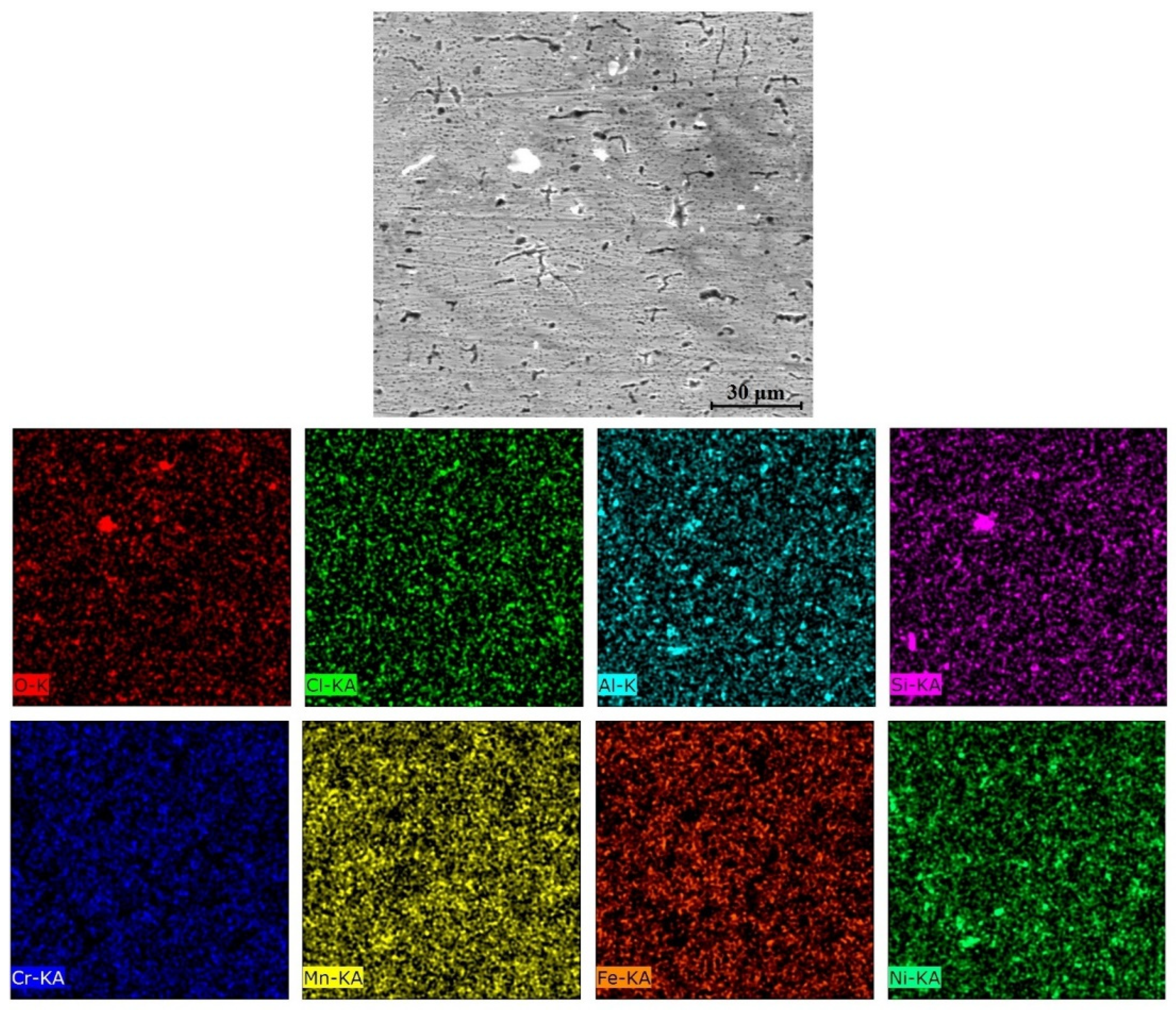
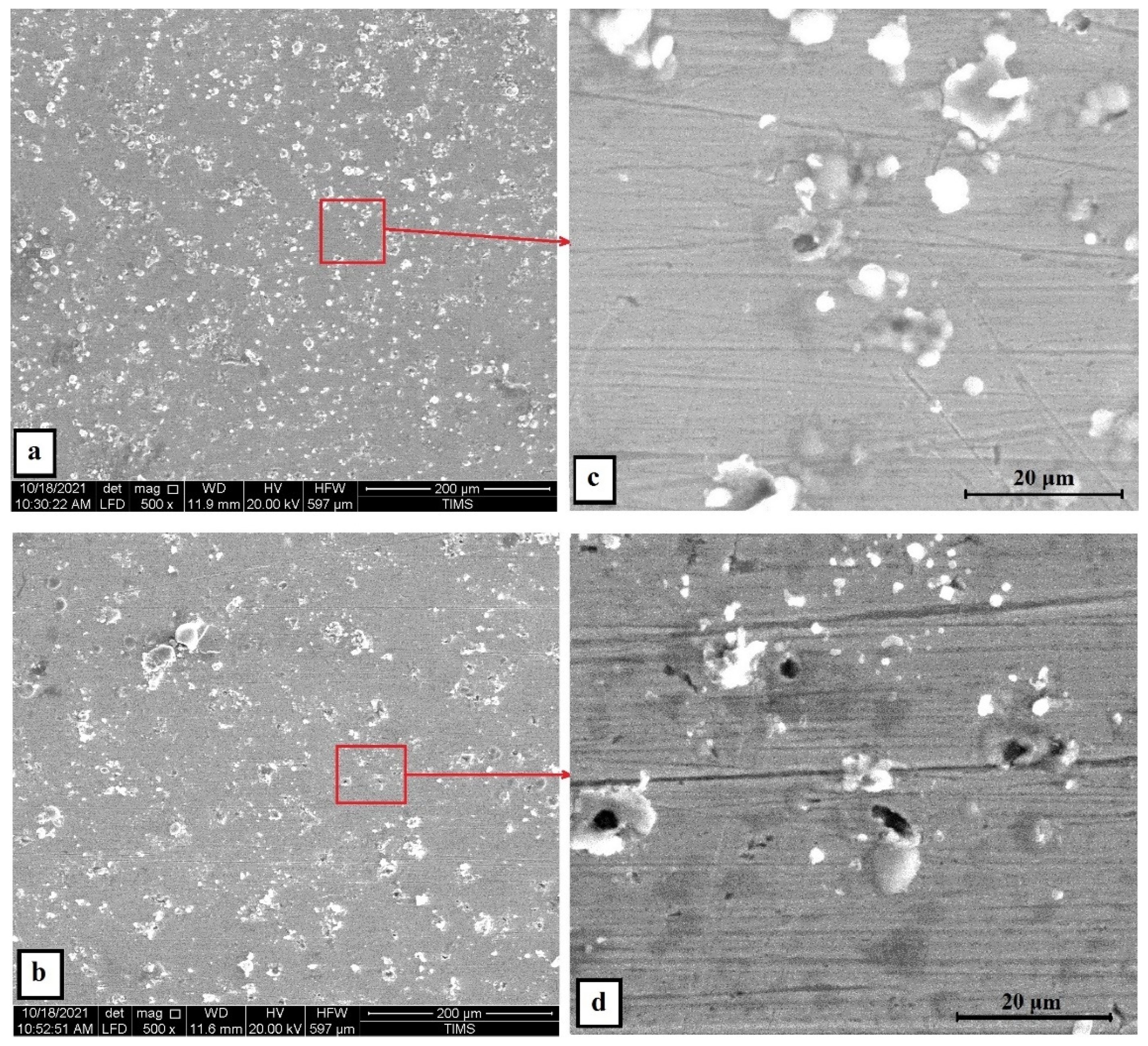

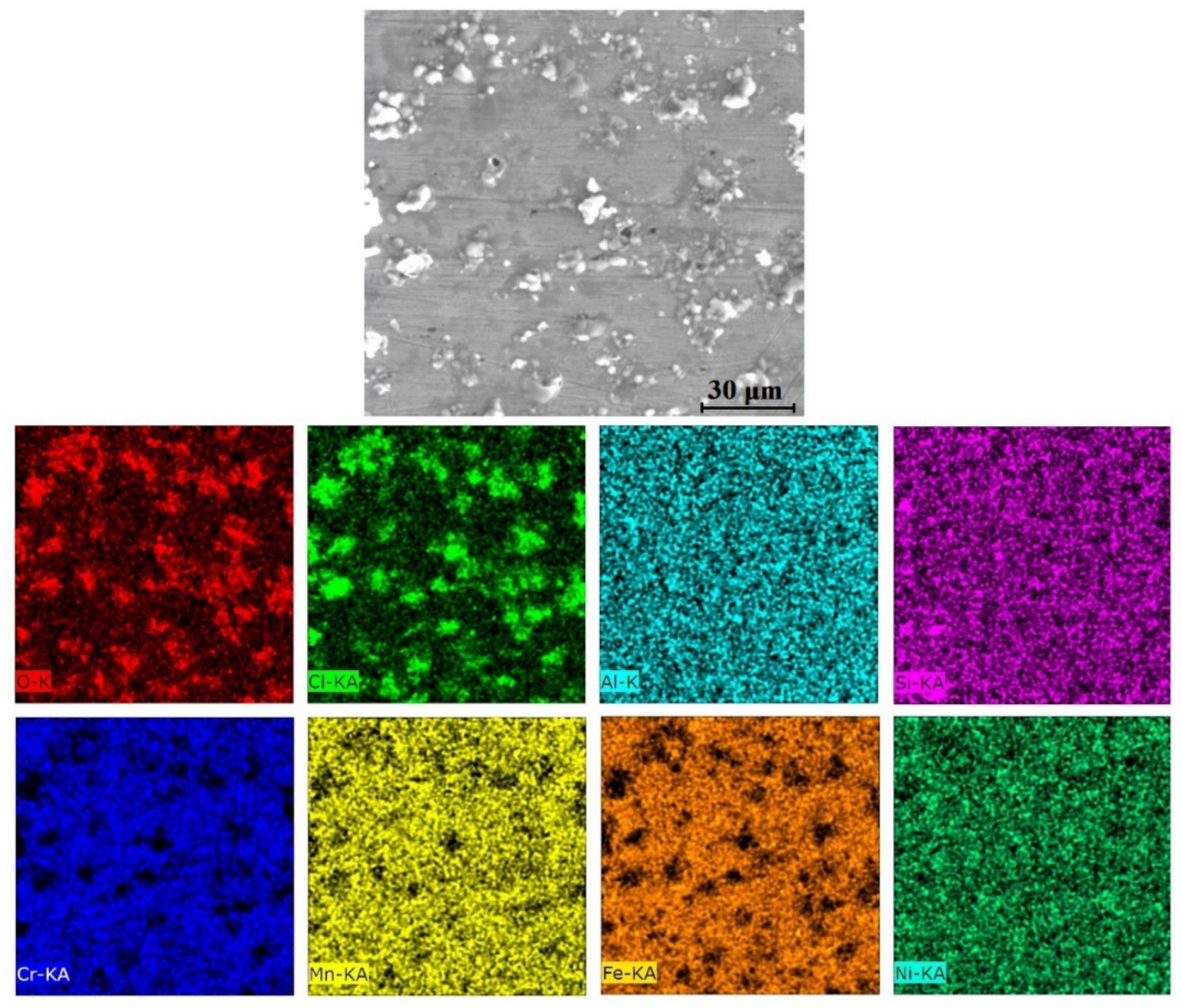

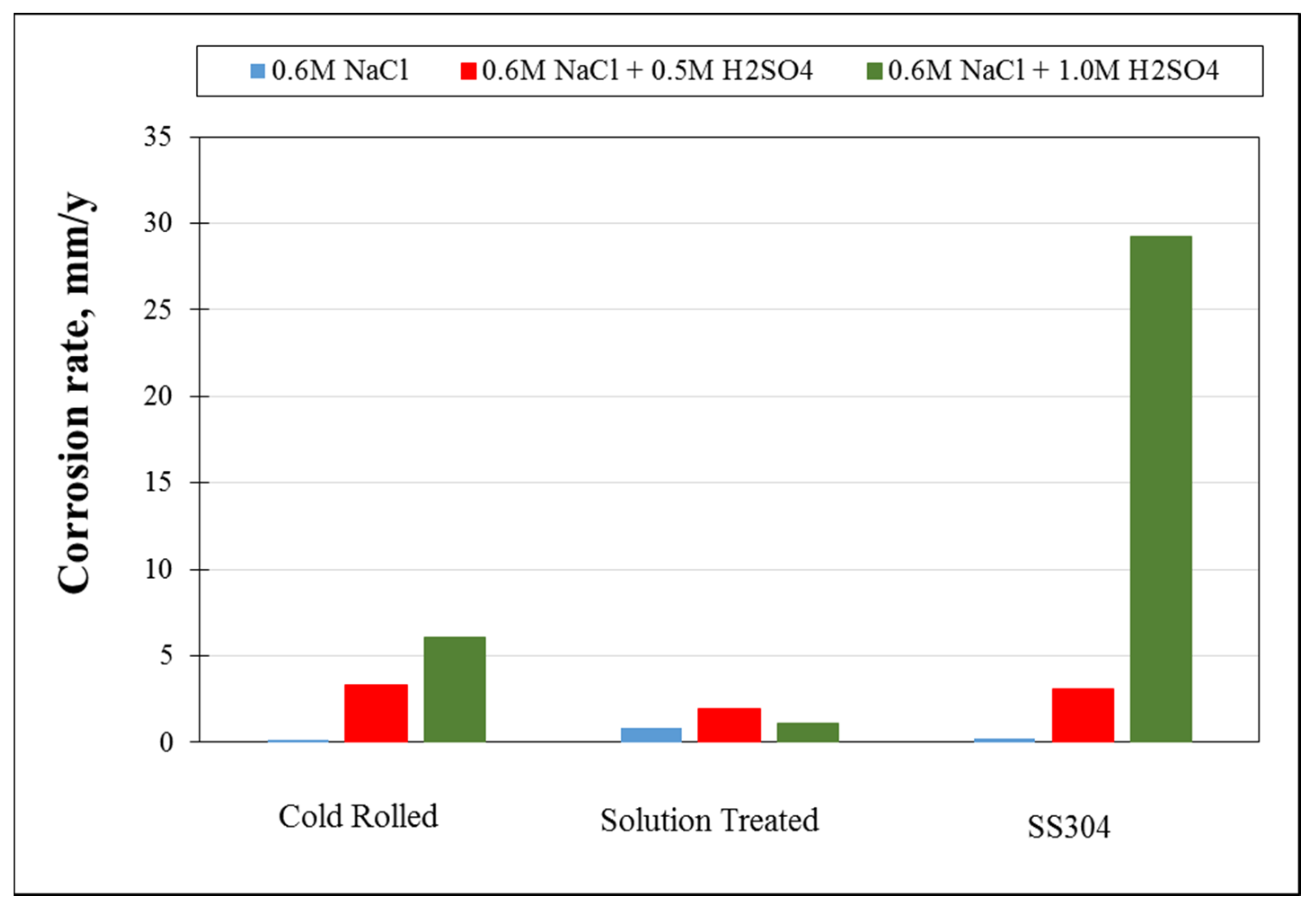
| Conditions | Ecorr, mV | icorr, µA/cm² | Rp, kohm.cm² | CR, mm/y | |
|---|---|---|---|---|---|
| Cold-rolled | 0.6 M NaCl | −455.1 | 12.70 | 33.00 | 0.136 |
| 0.6 M NaCl + 0.5 M H2SO4 | −546.1 | 309.96 | 1.70 | 3.33 | |
| 0.6 M NaCl + 1 M H2SO4 | −417.8 | 563.10 | 0.024 | 6.056 | |
| Solution-treated | 0.6 M NaCl | −403.8 | 75.85 | 13.43 | 0.815 |
| 0.6 M NaCl + 0.5 M H2SO4 | −497.1 | 178.8 | 5.57 | 1.92 | |
| 0.6 M NaCl + 1 M H2SO4 | −477.1 | 101.18 | 9.44 | 1.095 | |
| SS304 | 0.6 M NaCl | −261.2 | 22.4 | 8.77 | 0.241 |
| 0.6 M NaCl + 0.5 M H2SO4 | −417.8 | 288.2 | 0.402 | 3.10 | |
| 0.6 M NaCl + 1 M H2SO4 | −460.9 | 2715 | 0.095 | 29.20 | |
| Conditions | Elements, at.% | |||||||||
|---|---|---|---|---|---|---|---|---|---|---|
| O | Na | Cl | S | Al | Si | Cr | Mn | Fe | Ni | |
| Cold-rolled HEA | 12.6 | 2.4 | 0.0 | 0.0 | 4.0 | 3.8 | 16.0 | 18.1 | 31.1 | 12.0 |
| Solution-treated HEA | 2.1 | 0.0 | 0.0 | 0.0 | 4.7 | 2.8 | 19.0 | 15.8 | 39.5 | 16.3 |
| Conditions | Elements, at.% | |||||||||
|---|---|---|---|---|---|---|---|---|---|---|
| O | Na | Cl | S | Al | Si | Cr | Mn | Fe | Ni | |
| Cold-rolled HEA | 50.1 | 0.0 | 3.8 | 0.1 | 3.3 | 1.4 | 7.4 | 9.0 | 15.1 | 9.8 |
| Solution-treated HEA | 20.3 | 5.0 | 0.5 | 0.9 | 6.6 | 3.1 | 9.7 | 14.4 | 25.0 | 14.5 |
| Conditions | Elements, at.% | |||||||||
|---|---|---|---|---|---|---|---|---|---|---|
| O | Na | Cl | S | Al | Si | Cr | Mn | Fe | Ni | |
| Cold-rolled HEA | 56.5 | 0.0 | 9.5 | 0.0 | 6.0 | 1.2 | 2.1 | 5.9 | 6.1 | 12.7 |
| Solution-treated HEA | 52.0 | 0.2 | 8.3 | 0.1 | 3.8 | 1.0 | 5.7 | 8.1 | 9.7 | 10.9 |
Publisher’s Note: MDPI stays neutral with regard to jurisdictional claims in published maps and institutional affiliations. |
© 2022 by the authors. Licensee MDPI, Basel, Switzerland. This article is an open access article distributed under the terms and conditions of the Creative Commons Attribution (CC BY) license (https://creativecommons.org/licenses/by/4.0/).
Share and Cite
Mahmoud, E.R.I.; Mohamed, L.Z.; Gepreel, M.A.; Ebied, S.; Abdelfatah, A. Corrosion Behavior of Cold-Rolled and Solution-Treated Fe36Mn20Ni20Cr16Al5Si3 HEA in Different Acidic Solutions. Materials 2022, 15, 7319. https://doi.org/10.3390/ma15207319
Mahmoud ERI, Mohamed LZ, Gepreel MA, Ebied S, Abdelfatah A. Corrosion Behavior of Cold-Rolled and Solution-Treated Fe36Mn20Ni20Cr16Al5Si3 HEA in Different Acidic Solutions. Materials. 2022; 15(20):7319. https://doi.org/10.3390/ma15207319
Chicago/Turabian StyleMahmoud, Essam R. I., Lamiaa Z. Mohamed, Mohamed A. Gepreel, Saad Ebied, and Aliaa Abdelfatah. 2022. "Corrosion Behavior of Cold-Rolled and Solution-Treated Fe36Mn20Ni20Cr16Al5Si3 HEA in Different Acidic Solutions" Materials 15, no. 20: 7319. https://doi.org/10.3390/ma15207319
APA StyleMahmoud, E. R. I., Mohamed, L. Z., Gepreel, M. A., Ebied, S., & Abdelfatah, A. (2022). Corrosion Behavior of Cold-Rolled and Solution-Treated Fe36Mn20Ni20Cr16Al5Si3 HEA in Different Acidic Solutions. Materials, 15(20), 7319. https://doi.org/10.3390/ma15207319








